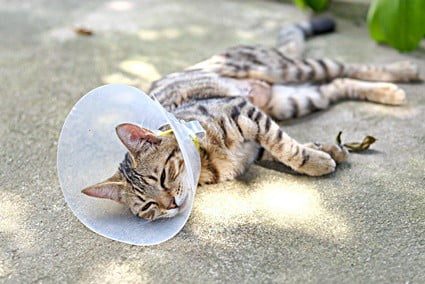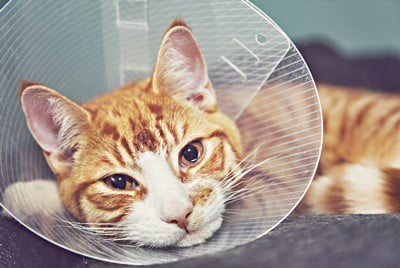After a wound has been stitched, a cat may scratch the site of the incision because the shaved area becomes itchy as the hair grows back and the area heals. The cat may scratch its neck wound as a natural response to reduce irritation, but scratching can remove sutures and cause bleeding or infection.
Cats should wear an Elizabethan collar (e-collar) to stop them from scratching, biting, or licking their neck during the healing and recovery process. Making a loud noise whenever your cat attempts to scratch its neck can be a good temporary distraction.
If your cat scratches its neck too aggressively, this will likely lead to an open, raw neck wound. If this happens, check for signs of a bacterial infection, such as swelling, oozing, and redness.
Why Won’t My Cat Stop Scratching Its Neck Raw?
In most cases, cats scratch their necks constantly because the affected area starts to feel itchy.
Common reasons for itchy wounds include:
- Hair growing back (if the area was shaved)
- Formation of scabs
- Bacterial infection
- Fleas, mites, or ticks
- Allergies (food, dust, or environmental irritants)
- Throat discomfort
- Pain-related stress
While a cat may scratch the area to alleviate itching, constant scratching can stop the healing process. Also, it can introduce bacteria to an open wound, making it larger or removing sutures.
Neck Collar to Prevent Cat from Scratching
You can temporarily stop your cat by moving its head or using commands (such as “stop”). Obviously, this isn’t going to work when you’re not around, or you’re asleep.
So, VCA Animal Hospital recommends wearing a collar to stop a cat from scratching its neck raw. Your vet will find the right-fitting collar during your visit; the collar should fit snuggly around your cat’s neck so that it can’t access the wound.
There are two types of collars used:
- The Elizabethan collar (e-collar)
- A bandage
1/ Elizabethan Collar (E-Collar)
The e-collar resembles a cone, and it surrounds the head, preventing the cat from reaching the site of the wound, allowing a normal and healthy recovery to occur.
Because the collar is cone-shaped, it prevents the cat from scratching any neck and face wounds, so it won’t be able to scratch itself by rubbing its body or head against the ground or nearby objects.
E-collars will temporarily affect your cat’s peripheral vision and hearing, so cats should be kept indoors.
It can take days for a cat to adjust to wearing a collar, and some cats will become obsessed with removing the collar. So, a cat may rub itself against the floor, walls, furniture, scratching posts, and your legs.
Occasionally, cats refuse to eat because they feel too stressed.
How To Stop A Cat from Taking it’s E-Collar Off
The e-collar is the best way to stop a cat from biting at and chewing on a neck wound.
Here are some ways to keep the collar in place:
- Put a regular collar on the cat before tying the e-collar so that it’s harder to pull off.
- Tie a bandage through the loops of the cone and crossing down the chest, behind the front legs, and once more on its back. Connect to the cone loops and tie a bow on the back.
- Use calming pheromones, such as Feliway, if your cat is stressed.

2/ Soft And Flexible Collars
Soft collars are easy to put on cats and far more comfortable than e-collars.
Your cat can easily eat, drink, and sleep with a soft collar because it drapes downward from the area of attachment (a reverse cone). Also, a cat will find it more difficult to pull off a soft collar.
The only downside to a soft collar is that it offers less protection than an e-collar. However, some owners prefer them over a traditional cone. They’re more comfortable for the cat, making them less distressing and more acceptable to owners.
Browse through different varieties of soft collars, depending on the cat’s wound. Also, consider the challenges it faces with wearing a traditional Elizabethan collar.
3/ Neck Bandaging
Bandaging the neck can prevent your cat from causing any further harm to its existing injury when it tries to scratch itself.
You can bandage a cat’s neck wound using stretch gauze and some self-sticking gauze, but don’t tie it too tightly. A light bandage is an effective barrier against a cat’s paws, so tie it loosely.
You should be able to slide in two fingers under the bandage without them squeezing through. If it isn’t easy to pass two fingers through, the bandage is too tight and is unsafe to wear.
However, the presence of a bandage will cause your cat to scratch even more. Some cats don’t want anything on their skin and will continuously chew, scratch, and lick until the foreign item comes off.
You can use a sock as a bandage for your cat’s neck wound:
- Cut the ankle off the sock, making the hole the size of your cat’s neck.
- Slide the sock over your cat’s head. If the sock is tight, stretch it out to loosen it before putting it over your cat’s head.
Whether you’re applying a bandage or using a sock, keep the material dry/clean and change it daily.
4/ Baby Onesie or Small Dog Sweater
If you opt for a baby onesie, baby sizes 3-6 months or 6-9 months work well for cats, depending on how big or small they are.
Also, dog sweaters designed for chihuahuas or small dogs are an ideal fit for a cat. Some dog sweaters come in extra small and small sizes, so find out what works for your cat.
Small sweaters and onesies are good alternatives to cones, especially if a cone irritates a neck injury or a cat persistently tries to take the cone off. Although some cats may find clothing irritating initially, they quickly learn to tolerate them and stop noticing them after a while.
If a onesie or dog sweater seems too tight, stretch it out before putting it on your cat.
Keep your cat’s sweater or onesie clean and dry at all times.
Is There Another Reason for the Itchiness?
After surgery or an injury to the neck, some cats scratch themselves for short periods due to temporary discomfort or because they feel like there’s something on their fur.
However, if your cat scratches the same area compulsively, there could be a second issue that’s gone unnoticed. Causes of itchiness in cats include fleas and ticks, allergies, throat discomfort, and anxiety.
Fleas are the most common explanation, but there are other reasons why a cat can be itchy. You can only control your cat’s scratching by finding out the underlying cause and rectifying it.

Allergies
A radioallergosorbent test (a blood test) can be used to check if a cat is allergic to certain antigens.
If your cat scratches its neck due to a food allergy, a vet will recommend an alternative diet.
If the cat has an environmental allergy, reducing a cat’s exposure to allergens (dust, mites, chemicals, and pollen) reduces the risk of scratching.
A vet may prescribe antihistamines to relieve any itchiness the cat’s experiencing.
Parasites
Fleas gather around a cat’s head and neck, causing itchiness. You may notice black scabs forming as the cat scratches at these areas to remove the irritant.
Use an anti-flea treatment regularly, but you may wish to avoid flea collars as they contain chemicals that can lead to allergic reactions in some cats.
Stress And Anxiety
Some cats may scratch their fur compulsively because they feel anxious or stressed. To identify the cause, consider any recent changes in your cat’s lifestyle.
- Has your cat’s food been changed?
- Did your cat recently lose a close member of its family?
- Is its resting environment too loud or unclean?
- Have you changed the position of any furniture, food bowls, or litter trays?
Addressing the source of stress and anxiety will prevent your cat from scratching its neck constantly.
Throat Discomfort
Your cat will scratch its neck, even if the source of the discomfort is inside the throat. It’s usually easy to detect a sore throat from your cat’s vocalizations.
Thin and raspy sounds, or sudden silence or passiveness, are common signs of throat pain. Also, a cat may exhibit some behavioral changes, such as a reluctance to eat its food.
It’s most likely that the cat’s neck is itchy due to the natural wound healing process. However, you should check for other health problems as a precautionary measure.
If a cat’s neck wound isn’t healing, schedule an appointment with a vet. An illness (such as diabetes) or an immune system problem may be allowing your cat’s wound to close or heal properly.


My cat has a wound on his neck, so I can’t use a collar because it would sit on the wound. My friend told me to try the baby onesie because it means he will be too uncomfortable to use his back legs to scratch the wound but i’m not convinced.
If the wound is still exposed, I reckon he will still scratch it. The vet I went to told me that the antibiotics would stop him from scratching the wound, which is a lie! A cat who has the area around the wound shaved, will scratch as the hair is growing back and as the skin starts to heal over, regardless of antibiotics or not. I suspect the vet just wanted me to have to come back to be charged for another consultation when he could have just told me in advance what needed to be done in one consultation.
I have a 13yr old diabetic cat with a neck/shoulder wound that is not healing at all. I have tried all kinds of wound healing sprays, washing with salt water, non stick pads, and stretch bandaging for a month now. Nothing is working and its not easy to see this…she has seen vet and had a 2 week anti biotic jab and anti inflammatory drops …still the same. How can this heal?? I am at my wits end to think of any other ways to help. back at vets in a week.
Hi June, did you find a solution? I’m going through the same with my cat atm, having spent over £200 at the vets, antibiotics, medical suits, steroids etc etc, every chance he gets he scratched it, this is about the 3rd scab he’s clawed off, I too am at my wits end
I have the same problem. Looking for ideas.
i have this problem as well. The sore is on the neck about 1/2 inch behind the right ear. Here are a few ideas I have tried. All work to a certain degree. Take a foam paper plate and cut a circle in the middle. Slide over the head, works like an elizabethan collar. I trimmed the plate to make it smaller where it went under the neck. Then taped a large coin or washer to weighted it so to stay in place. It works for 2 or 3 days, before she rubs it off against a door. Another idea I tried was to take a sock and cut it to create a scrunchie type band. I tried cutting ear holes to hold in place but my cat has small ears and she flatten them. I trimmed the claws, and then taped the right foot. I used a white, “paper-like” medical tape. Covering those claws well but not tight. I put liquid bandage on the sore. It probably stung, it does on me on a open wound! I open antibiotic capsules and dump a small amount of powder directly on the wound. I have use DMSO, diluted 50% with water on the wound, then few min later put the antibiotic powder on the wound.
I thought maybe her ears were itchy, though she has always been a cat that cleans herself a lot. I cleaned her ears. I rub a bit of coconut oil in the ears every few weeks and wipe them out. I changed her food to high protein kibble with canned. All these things have helped. But this is a ongoing thing. We are talking 3+ years. Heals and then she scratches it open again. She is currently taking amoxicillin in her food as well. She is 13/14 y.o. Still very active and the boss of the dog and male cat!
My 15 year old cat has Bowens Disease which has caused an open sore on the back of neck and shoulder. He can no longer have surgery because he can’t tolerate it. This wound will never heal because of the disease. I am trying to keep him from digging at it but without much luck. A collar would ride right over it and rub it raw worse. I am trying onesies and small dog covers so far without any luck. They go below the sore. I have tried wrapping it with gauze he gets it down. I have tried covering his back leg with a sock to mute the nails digging at it but again he gets it off. I am so at a loss. I want to help him but not sure how.
Hi Susan
My cat doesn’t have any disease, he had a very small scab from going through a fence, it had healed but he decided to scratch the scab off and has made a right mess of his neck. I’ve spent a fortune at the Vets, bought medical suits and each time it scabs he scratches it off. Ive tried raw aloe Vera which does soothe it for him. I’m now thinking of leaving it alone and letting the air get to it. Otherwise I’ve no idea what to do next
Hey,
There are currently 5 cats between my partner and myself. One of the cats, we had since she was 4 weeks old and is now 2 years old. For a few months now we’ve been dealing with an ongoing struggle of an ear infection and scabs she keeps reopening on her face. I’ve also spend tons of money on sprays, rear paw shoes, medications, topical ointments, isolatinf her food and giving her vet food, simply coning her, and vet visits. None of it has worked and I’m also at my wits end.
I’ve also tried pure aloe with a little apple cider vinegar to help soothe her itching and kill some bacteria on her face. She seems to like that until her skin and face scabs get dry and she must scratch using whatever she can find. We currently have a cone on her and are afraid of taking it off because she will leave her entire face bloody without any ability to open her eyes, if we let her. It’s been a few months now and I find some solutions, like wrapping her rear paws and front paws. And putting her in one of the cat carriers near a closed window so she has time to clean herself and feel like a normal cat.
She’s so creative with how she reopens her face wounds that tapping all edges around the house are not enough. She rubs against walls and rolls around in her litter. Which literally always makes her face worse. I constantly have to monitor her and clean her wounds with fungal killing topical medicine. But again, it’s not enough and I’m looking around for vets now. Hoping to find one that doesn’t bankrupt me and not actually solve the issue. *sigh
Has anyone tried trimming their nails? My geriatric cat never goes outdoors, so I wondered if nail trimming may work for her.
My daughters cat is scratching her neck, the vet gave us cream and trimmed her nails etc, almost $1000 spent already, she only does this in the summer, she has flea meds on. Any ideas?
I have this exact problem with my cat who has large areas of open sores on her neck caused by arthritis injections. She scratches off the scabs which itch once formed, so opens them up thus back to square one. I have discontinued the injections and there’ll be around 120 days before the drug fully leaves her body. In the meantime I am bathing the wounds with water and nano silver to prevent infection; drying the area then applying an emollient/anti-itch treatment called Anicura to sooth it. This 3 times a day. She is having red light therapy for 5 minutes twice a day and has an inflatable donut collar arriving tomorrow so she can’t scratch. Fortunately she is a trusting and tolerant cat and doesn’t make any fuss at all. I’ll post an update as, if or when things change. I don’t envy anyone whose pet has this problem.